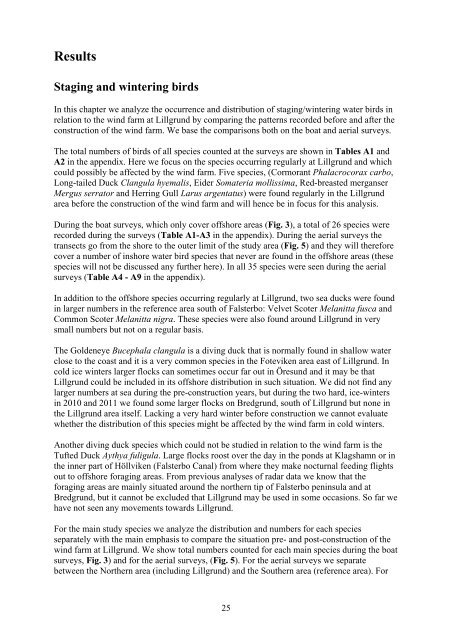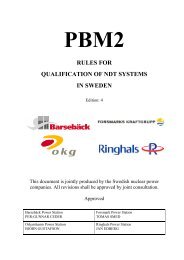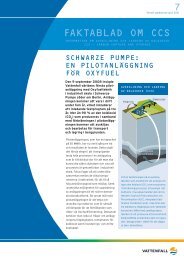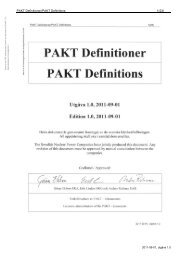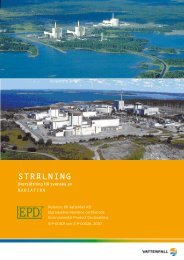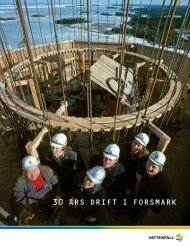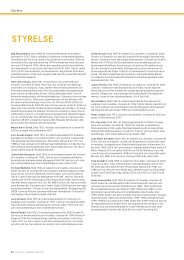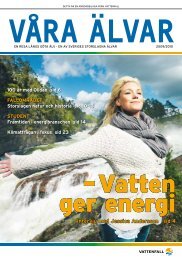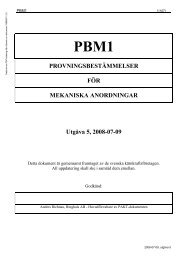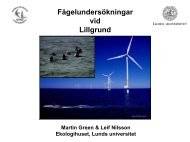Birds in southern Öresund in relation to the wind farm at ... - Vattenfall
Birds in southern Öresund in relation to the wind farm at ... - Vattenfall
Birds in southern Öresund in relation to the wind farm at ... - Vattenfall
You also want an ePaper? Increase the reach of your titles
YUMPU automatically turns print PDFs into web optimized ePapers that Google loves.
Results<br />
Stag<strong>in</strong>g and w<strong>in</strong>ter<strong>in</strong>g birds<br />
In this chapter we analyze <strong>the</strong> occurrence and distribution of stag<strong>in</strong>g/w<strong>in</strong>ter<strong>in</strong>g w<strong>at</strong>er birds <strong>in</strong><br />
<strong>rel<strong>at</strong>ion</strong> <strong>to</strong> <strong>the</strong> w<strong>in</strong>d <strong>farm</strong> <strong>at</strong> Lillgrund by compar<strong>in</strong>g <strong>the</strong> p<strong>at</strong>terns recorded before and after <strong>the</strong><br />
construction of <strong>the</strong> w<strong>in</strong>d <strong>farm</strong>. We base <strong>the</strong> comparisons both on <strong>the</strong> bo<strong>at</strong> and aerial surveys.<br />
The <strong>to</strong>tal numbers of birds of all species counted <strong>at</strong> <strong>the</strong> surveys are shown <strong>in</strong> Tables A1 and<br />
A2 <strong>in</strong> <strong>the</strong> appendix. Here we focus on <strong>the</strong> species occurr<strong>in</strong>g regularly <strong>at</strong> Lillgrund and which<br />
could possibly be affected by <strong>the</strong> w<strong>in</strong>d <strong>farm</strong>. Five species, (Cormorant Phalacrocorax carbo,<br />
Long-tailed Duck Clangula hyemalis, Eider Som<strong>at</strong>eria mollissima, Red-breasted merganser<br />
Mergus serra<strong>to</strong>r and Herr<strong>in</strong>g Gull Larus argent<strong>at</strong>us) were found regularly <strong>in</strong> <strong>the</strong> Lillgrund<br />
area before <strong>the</strong> construction of <strong>the</strong> w<strong>in</strong>d <strong>farm</strong> and will hence be <strong>in</strong> focus for this analysis.<br />
Dur<strong>in</strong>g <strong>the</strong> bo<strong>at</strong> surveys, which only cover offshore areas (Fig. 3), a <strong>to</strong>tal of 26 species were<br />
recorded dur<strong>in</strong>g <strong>the</strong> surveys (Table A1-A3 <strong>in</strong> <strong>the</strong> appendix). Dur<strong>in</strong>g <strong>the</strong> aerial surveys <strong>the</strong><br />
transects go from <strong>the</strong> shore <strong>to</strong> <strong>the</strong> outer limit of <strong>the</strong> study area (Fig. 5) and <strong>the</strong>y will <strong>the</strong>refore<br />
cover a number of <strong>in</strong>shore w<strong>at</strong>er bird species th<strong>at</strong> never are found <strong>in</strong> <strong>the</strong> offshore areas (<strong>the</strong>se<br />
species will not be discussed any fur<strong>the</strong>r here). In all 35 species were seen dur<strong>in</strong>g <strong>the</strong> aerial<br />
surveys (Table A4 - A9 <strong>in</strong> <strong>the</strong> appendix).<br />
In addition <strong>to</strong> <strong>the</strong> offshore species occurr<strong>in</strong>g regularly <strong>at</strong> Lillgrund, two sea ducks were found<br />
<strong>in</strong> larger numbers <strong>in</strong> <strong>the</strong> reference area south of Falsterbo: Velvet Scoter Melanitta fusca and<br />
Common Scoter Melanitta nigra. These species were also found around Lillgrund <strong>in</strong> very<br />
small numbers but not on a regular basis.<br />
The Goldeneye Bucephala clangula is a div<strong>in</strong>g duck th<strong>at</strong> is normally found <strong>in</strong> shallow w<strong>at</strong>er<br />
close <strong>to</strong> <strong>the</strong> coast and it is a very common species <strong>in</strong> <strong>the</strong> Foteviken area east of Lillgrund. In<br />
cold ice w<strong>in</strong>ters larger flocks can sometimes occur far out <strong>in</strong> <strong>Öresund</strong> and it may be th<strong>at</strong><br />
Lillgrund could be <strong>in</strong>cluded <strong>in</strong> its offshore distribution <strong>in</strong> such situ<strong>at</strong>ion. We did not f<strong>in</strong>d any<br />
larger numbers <strong>at</strong> sea dur<strong>in</strong>g <strong>the</strong> pre-construction years, but dur<strong>in</strong>g <strong>the</strong> two hard, ice-w<strong>in</strong>ters<br />
<strong>in</strong> 2010 and 2011 we found some larger flocks on Bredgrund, south of Lillgrund but none <strong>in</strong><br />
<strong>the</strong> Lillgrund area itself. Lack<strong>in</strong>g a very hard w<strong>in</strong>ter before construction we cannot evalu<strong>at</strong>e<br />
whe<strong>the</strong>r <strong>the</strong> distribution of this species might be affected by <strong>the</strong> w<strong>in</strong>d <strong>farm</strong> <strong>in</strong> cold w<strong>in</strong>ters.<br />
Ano<strong>the</strong>r div<strong>in</strong>g duck species which could not be studied <strong>in</strong> <strong>rel<strong>at</strong>ion</strong> <strong>to</strong> <strong>the</strong> w<strong>in</strong>d <strong>farm</strong> is <strong>the</strong><br />
Tufted Duck Aythya fuligula. Large flocks roost over <strong>the</strong> day <strong>in</strong> <strong>the</strong> ponds <strong>at</strong> Klagshamn or <strong>in</strong><br />
<strong>the</strong> <strong>in</strong>ner part of Höllviken (Falsterbo Canal) from where <strong>the</strong>y make nocturnal feed<strong>in</strong>g flights<br />
out <strong>to</strong> offshore forag<strong>in</strong>g areas. From previous analyses of radar d<strong>at</strong>a we know th<strong>at</strong> <strong>the</strong><br />
forag<strong>in</strong>g areas are ma<strong>in</strong>ly situ<strong>at</strong>ed around <strong>the</strong> nor<strong>the</strong>rn tip of Falsterbo pen<strong>in</strong>sula and <strong>at</strong><br />
Bredgrund, but it cannot be excluded th<strong>at</strong> Lillgrund may be used <strong>in</strong> some occasions. So far we<br />
have not seen any movements <strong>to</strong>wards Lillgrund.<br />
For <strong>the</strong> ma<strong>in</strong> study species we analyze <strong>the</strong> distribution and numbers for each species<br />
separ<strong>at</strong>ely with <strong>the</strong> ma<strong>in</strong> emphasis <strong>to</strong> compare <strong>the</strong> situ<strong>at</strong>ion pre- and post-construction of <strong>the</strong><br />
w<strong>in</strong>d <strong>farm</strong> <strong>at</strong> Lillgrund. We show <strong>to</strong>tal numbers counted for each ma<strong>in</strong> species dur<strong>in</strong>g <strong>the</strong> bo<strong>at</strong><br />
surveys, Fig. 3) and for <strong>the</strong> aerial surveys, (Fig. 5). For <strong>the</strong> aerial surveys we separ<strong>at</strong>e<br />
between <strong>the</strong> Nor<strong>the</strong>rn area (<strong>in</strong>clud<strong>in</strong>g Lillgrund) and <strong>the</strong> Sou<strong>the</strong>rn area (reference area). For<br />
25


